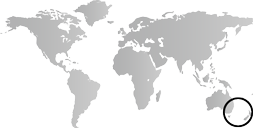During the nineteenth century, European and American cultural and political influences continue to spread throughout the widely separated islands of Polynesia. In the early 1800s, European explorers encounter and survey the region’s remaining uncharted islands. These explorers are followed, in some instances preceded, by commercial vessels such as whalers, sealers, and traders in sandalwood, a fragrant timber highly valued in the flourishing trade with China. The first half of the century also sees a marked increase in the intensity and extent of missionary activity across the region as the first missionaries arrive in New Zealand, Tonga, Hawai’i, Samoa, and Fiji. In addition to the growing cultural changes brought about directly by European and American sailors, missionaries, and traders, many Polynesian peoples in the nineteenth century are devastated by epidemics of introduced diseases, which, in some places, kill as much as 90 percent of the population. This drastic depopulation severely disrupts many Polynesian societies. Since knowledge among Polynesian peoples is transmitted orally, depopulation also threatens, and in some instances interrupts, the continuity of many of the region’s cultural and artistic traditions. Despite the growing impact of their encounters with outsiders, Polynesian peoples in the first four decades of the nineteenth century remain politically independent. Indeed some individuals, such as Kamehameha (ca. 1758–1819), who establishes the Hawaiian monarchy by uniting the Hawaiian Islands under his rule with the aid of European weapons, are able to creatively exploit Western technology to further their personal and political ambitions.
The latter part of the nineteenth century is marked by the increasing political control of the individual regions of Polynesia by European and American colonial powers. In the 1840s, the British and Maori sign the Treaty of Waitangi, establishing British law in New Zealand, and France begins to lay claim to Tahiti and other parts of present-day French Polynesia. During the 1870s and 1880s, the British annex Fiji and the Cook Islands, while Tahiti is formally ceded to France and Easter Island to Chile. Backed by U.S. Marines, a group of American businessmen depose the Hawaiian monarchy in 1893 and the United States and Germany divide the islands of Samoa between them in 1899. By 1900, Tonga remains the only substantial independent political entity in Polynesia.
The tumultuous events of the nineteenth century have profound effects on Polynesian art. The conversion of Polynesian peoples to Christianity results in the destruction of much of Polynesia’s rich sculptural heritage, which missionaries and recent converts condemn as “idols.” A substantial number of the surviving Polynesian images are, ironically, collected by the missionaries themselves and sent back to Europe or America as evidence of their spiritual achievements. Others are acquired by explorers, colonists, and sailors and eventually make their way into Western museums and private collections. While the sculptural traditions associated with Polynesia’s indigenous religions decline or cease altogether, many more secular artistic traditions continue. These include important women’s art forms such as barkcloth and elaborately plaited mats as well as men’s art forms such as the carving of headrests, food pounders, and bowls.
The introduction of Western technology also sparks a renewed, though in some cases brief, efflorescence of Polynesian art. Equipped with newly acquired steel carving tools, many artists create exquisitely detailed works of immense artistic virtuosity and technical complexity, such as the intricately carved paddles of the Austral Islands, the lavishly adorned works of nineteenth-century Maori artists, and the striking ceremonial adzes of the Cook Islands. In other cases, new art forms evolve combining Polynesian and Western materials and techniques, such as the bold figurative painting tradition of the Maori or the sumptuously crafted rank insignia and luxury goods of the Hawaiian monarchy. Another nineteenth-century innovation among Polynesian artists is the development and elaboration of a wide variety of objects produced for sale to outsiders as curiosities.


